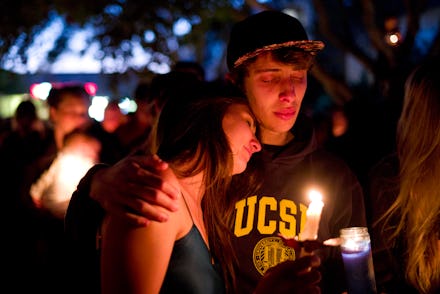Australia Has Eliminated Gun Massacres By Doing What the U.S. Doesn't Have the Guts For

The news: Mass shootings are in the news again, this time in Isla Vista, Calif., where a former Santa Barbara City College student killed six people after developing an uncontrollable hatred for women.
And still Congress finds itself not only far from considering effective new safeguards on firearms but actually largely sympathetic to loosening restrictions on them. Some states are even moving to lift pretty much all restrictions on when and where a gun can be carried. Earlier this year in Georgia, the state's "carry anywhere" legislation allowed guns in bars, churches and schools.
In an emotional video, a heartbroken father blamed the California massacre on "craven, irresponsible politicians and the NRA:"
There's another option. After a mass killing in 1996 at Port Arthur where 35 people died and 20 were injured, Australia passed a comprehensive firearms act that didn't ban guns but placed logical restrictions on them. Despite having a strong frontier gun culture, Australia went from a firearms mortality rate of 2.6 in 100,000 (one-quarter the U.S. rate) in 1996 to under one in 100,000, less than a tenth of the U.S. rate.
The background: National Journal has an extensive rundown of the Australian gun law and why it was so effective, but here's the nuts and bolts.
In the wake of the 1996 shootings, support for further gun control measures swelled to 90%-95% of the population. Spearheaded by Australia's conservatives — yes, really — the laws banned rapid-firing long guns and launched an extensive gun buyback program that removed over 650,000 guns from the public. It also tightened laws and regulations surrounding their sale, registration, and storage. The whole package cost about $500 per gun and was compulsory.
As a result, some estimates say 20% of Australia's total guns were eliminated and ownership by household halved. In the U.S., a similar law would get rid of 40 million firearms.
The decreasing homicide rate in Australia declined even faster, and mass shootings stopped entirely. Before the gun laws, Australia had seen 13 mass shootings, 112 resulting deaths, and 52 injured in the previous 18 years. Australia's never seen a similar massacre since. Meanwhile, the firearms suicide rate fell dramatically from about 492 a year to 247.
In Australia, fewer firearms meant fewer deaths. Americans don't have a comparable experience because there are 88.9 guns for every 100 citizens in the country. In the U.S., a 2013 study found that an increase of firearms ownership by 1% translates almost directly to a 1% increase in death by firearm.
Image: Credit: Mother Jones. Sources: Pediatrics, Centers for Disease Control and Prevention
What's more, it seems like a lot of people aren't capable of responsible firearms ownership: Mother Jones' Dave Gilson notes that "Drivers who carry guns are 44% more likely than unarmed drivers to make obscene gestures at others and 77% more likely to follow other vehicles aggressively," adding that Texans with concealed-carry permits were 4.8 times more likely to be sentenced for threatening someone with a gun than those who don't have one. "Stand your ground" laws have been tied to 7%-10% increases in homicides. More stringent controls on firearms could decrease the number of guns that get into the hands of murderers, criminals and the mentally ill.
Why you should care: Violence in America has been decreasing, but we have double the firearms death rate of second-place Finland. We can do better, and Congress has a responsibility to make stopping gun violence a priority or it will be complicit in America's elevated rate of deaths from murders, suicides and preventable accidents.